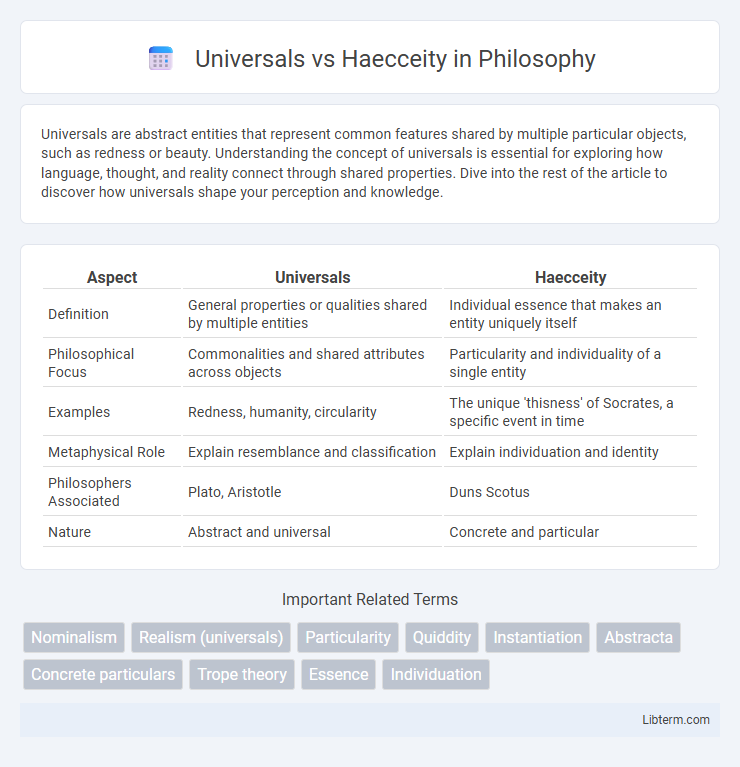Universals are abstract entities that represent common features shared by multiple particular objects, such as redness or beauty. Understanding the concept of universals is essential for exploring how language, thought, and reality connect through shared properties. Dive into the rest of the article to discover how universals shape your perception and knowledge.
Table of Comparison
| Aspect | Universals | Haecceity |
|---|---|---|
| Definition | General properties or qualities shared by multiple entities | Individual essence that makes an entity uniquely itself |
| Philosophical Focus | Commonalities and shared attributes across objects | Particularity and individuality of a single entity |
| Examples | Redness, humanity, circularity | The unique 'thisness' of Socrates, a specific event in time |
| Metaphysical Role | Explain resemblance and classification | Explain individuation and identity |
| Philosophers Associated | Plato, Aristotle | Duns Scotus |
| Nature | Abstract and universal | Concrete and particular |
Understanding Universals: A Philosophical Overview
Universals refer to properties or qualities shared by multiple particular entities, such as redness or beauty, which exist independently of individual instances. Haecceity, contrastingly, denotes the discrete, individual essence that makes an entity uniquely itself, emphasizing individuality over commonality. Understanding universals involves exploring their ontological status and role in metaphysics, highlighting debates on whether they exist objectively as abstract entities or only as conceptual constructs.
Defining Haecceity: The Principle of ‘Thisness’
Haecceity refers to the principle of 'thisness' that distinguishes a particular individual from all others, emphasizing its unique, concrete identity beyond general categories. Unlike universals, which represent shared properties or qualities applicable to many entities, haecceity captures the irreducible specificity that makes an entity uniquely itself. Philosophers such as Duns Scotus pioneered the concept to address how individual entities possess a distinctive essence that cannot be fully explained by universal traits.
Historical Development: From Plato to Medieval Thinkers
Plato introduced universals as ideal forms existing independently, representing the perfect essence of objects, while haecceity was less emphasized. Aristotle shifted focus to particulars with his concept of substance, grounding universals in concrete instances but not dismissing their reality. Medieval thinkers like Duns Scotus redefined haecceity as the "thisness" that individuates entities, distinguishing it from universal qualities and influencing scholastic debates on individuality and essence.
Universals vs Haecceity: Core Differences
Universals refer to properties or qualities shared by multiple particular objects, allowing them to be grouped under a common concept, such as redness or beauty. Haecceity, on the other hand, is the unique essence or "thisness" that individuates a particular object from all others, emphasizing its distinct identity. The core difference lies in universals representing shared characteristics across entities, while haecceity highlights the singular individuality that cannot be replicated.
Realism and Nominalism in the Debate
Realism asserts that universals, such as properties and types, exist independently of particular objects, grounding shared qualities in an objective reality beyond individual instances. Nominalism denies the independent existence of universals, arguing that only particular entities exist, and what we call universals are mere names or concepts without corresponding reality. The debate contrasts realism's commitment to abstract entities with nominalism's emphasis on particulars and linguistic conventions, shaping metaphysical discussions on the nature of reality and categorization.
Famous Philosophers: Positions and Arguments
Plato famously advocated for Universals, asserting that abstract Forms exist independently and serve as perfect templates for particular objects, while Aristotle refuted this by arguing Universals exist within things themselves, emphasizing concrete particulars. Duns Scotus introduced the concept of Haecceity as the unique "thisness" that individuates entities beyond their shared properties, contrasting with Thomistic views that prioritized Universals as primary reality. Contemporary debates often hinge on debates between Realists, who uphold the existence of Universals, and Nominalists or Particularists, who emphasize Haecceity to account for individual identity and differentiation.
Universals in Metaphysics and Ontology
Universals in metaphysics and ontology refer to properties or qualities that multiple entities can share, such as redness or circularity, existing independently of particular instances. They serve as the fundamental basis for understanding how different objects can resemble each other and participate in common traits, addressing problems of resemblance and classification. The study of universals contrasts with haecceity, which emphasizes the individual uniqueness or "thisness" of entities, underscoring the difference between shared attributes and individual identity.
Haecceity and Personal Identity
Haecceity, a concept introduced by philosopher Duns Scotus, refers to the unique, individual essence that distinguishes one entity from all others, emphasizing the irreducible particularity of personal identity. Unlike universals, which represent shared properties or qualities across multiple instances, haecceity grounds the singularity and concrete reality of a person's existence. This metaphysical focus on haecceity plays a critical role in debates on personal identity, underscoring how the individuality of a person cannot be fully explained by general traits or characteristics alone.
Contemporary Applications and Debates
The debate between universals and haecceity remains central in contemporary metaphysics, influencing theories in identity and individuality across philosophy and cognitive science. Universals address properties shared by multiple entities, essential for categorization and language semantics, while haecceity emphasizes the unique thisness of individuals, crucial in discussions of personal identity and quantum mechanics. Modern applications explore how these concepts affect artificial intelligence, ontological modeling, and the interpretation of physical reality in both scientific and metaphysical frameworks.
Conclusion: Reconciling Universals and Haecceity
Reconciling universals and haecceity involves recognizing that while universals represent shared properties across multiple entities, haecceity captures the distinct individuality of a particular entity. Philosophical frameworks like moderate realism propose that universals exist in particular things but are instantiated uniquely in each entity's haecceity. This synthesis allows for a comprehensive understanding of both commonalities and individuality, bridging abstract categories with concrete uniqueness.
Universals Infographic

 libterm.com
libterm.com